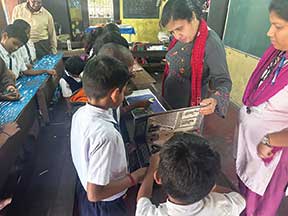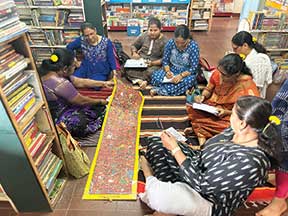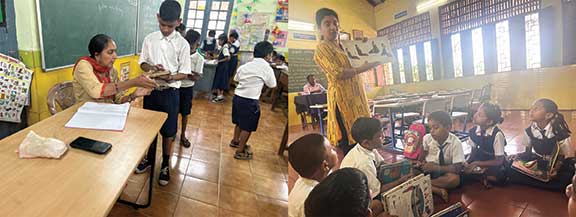A government school teacher, who has been with the Libraries in School program for a few years, writes in her note at the end of a meeting on school libraries.

“We had a wrong understanding of the library earlier. Library means silent reading, no moving, according to us. But through Bookworm there are a number of activities that we learnt and are learning that the library can provide. We can enjoy, express ourselves. Reading silently is no longer our assumption.”
As we scan the notes of almost one hundred teachers who have interacted with the Libraries in School program over these past few years, we read similar voices.
“Children enjoy all the activities held by the team, regularly take home books and read them, and discuss the stories with each other. Children wait for Melcom’s session.”
As we close another year of working with government primary teachers in two talukas (Ponda and Tiswadi) of small Goa, we pause to reflect on what is happening. How has this come to pass? Why are we experiencing this rush when merely a few years back the climate was dry and uninterested in the space of the library to transform children’s learning experiences?

We began a journey with reaching children in small under-resourced (in terms of library) schools as far back as 2011. We began with collections of books – curated and exciting, but learnt that that was not enough. From 2014, we began to hold library classes to very high responses from children, and since 2017, thanks to strong funder support from our partner Cipla Foundation, we also resource schools with a collection, display material, stationery, activity resources, signage, and sometimes a bookshelf besides mentoring visits. From those early years of full and consistent support from us, the holding team initiated contact, negotiated for time, conducted story hour, created space and opportunities for browsing and borrowing, made home visits, managed the inventory, designed activities, listened deeply to children and observed responses and documented whilst also doing library record keeping. Tasks and functions that constitute library work but in settings that were not library friendly – either physically or emotionally. Year after year it was the responses of the children that enabled us to simply go on. We learnt from teachers that attendance was higher on library days. We began to be careful about not showing ourselves in the corridor before our class time because one peek of a library educator and 30 pairs of eyes turned towards the windows. We would stand in the door frame and hear excited voices ‘aile aile’ (they’ve come, they’ve come) and often ‘kitem adlem’ (what did you bring) – not meaning things but stories. Heady and deeply stirring times those were!
But what we did not pay close attention to is that the process of observation can be two ways – we were also being observed by the teachers and the children’s responses to the library were also being observed. Another teacher writes,
“Children like reading books. During the recess there are also discussions about books that they read, there are also recommendations to each other saying I read that book and it’s a good story, you too should read.”

Over a decade of classroom work with library has demonstrated that there is not a single session where children did not respond to the story. While we can lay claim to a responsive, culturally rich pedagogy of library practice, including selection we must also honour the very act of the story itself and how it has the potential to transform. We affirm that selecting books carefully and in conjunction with children (by taking into account their interests, their experience with books and such), and curating, planning and conducting read-alouds that trigger thinking and feeling are the key aspects of an engaged class.
But by being in the library sessions, stories are also acting upon teachers. This enabled us after a couple of years to invite teachers into workshops to talk about what is possible with stories. Teachers began to read and engage with books and over the past three years are able to talk of collection in the classroom with more nuance because of direct engagement.
“Children read books, Bookworm has provided the school with quality picture books, which children enjoy to look at. There are also books that have touch and feel texture which brings in the sense of certain things/objects through the books. Some books are a little difficult to read but children don’t hesitate to take them home, as they do picture reading. We have also fixed timings for the library activities, which we were not doing before.”
As we look back on our Libraries in School program we acknowledge that we drew inspiration from many who had gone before while also striking our own path. Understanding the socio-cultural perspective on literacy and language has rooted our framework in language and life. Theorists like Jerome Bruner, Gordon Wells, James Britton, Shirly Brice Heath, Lisa Delpit, bell hooks, B R Ambedkar, Paulo Freire and so many more thinkers give us the seeds on which our program grows.

We chose to not pay attention to the larger narrative of the overwhelmed or fatigued school teacher, but to trust in the children and their participation as a stimulus for attention. We consistently choose to daydream like Laxmiram in Gijubhai Badheka’s Divasvapna (1931) and find a way to start library work in small schools. We exposed our teachers to models of trust and participation as against descriptions of failure especially around ‘culturally diverse’ student populations. We invited teachers into conversations around books, library and learning that disrupted narrow ideas of books for leisure, books for creativity, books for morals, towards books and libraries for thinking, feeling, responding and becoming more conscious and compassionate humans in a polarized world.
“Library was thought of as only for reading. But now through sessions, new ideas come along with the activities. Library by Bookworm in the school is very helpful.”
The library in the way we now understand and recognize it, is so much more than a tool and medium towards foundational literacy. We feel incredibly excited to stand with government school teachers who are also recognizing this. We sense an emerging concern of being railroaded by the instrumental ideas of reading around phonology, decoding, fluency that is currently the discourse of the early years around NEP 2020 but we remind ourselves that teaching and learning are political acts, that they are transformative acts and that only in being present, working alongside and with compassion will we be able to also play our part in this cultural work that we call education.
If you would like to begin a Libraries in School program we recommend the following
BEGIN
TRUST
REACH OUT
COMMIT
For any further support email lis@bookwormgoa.in.
Article contributed by the Libraries in Schools team at Bookworm Goa.
